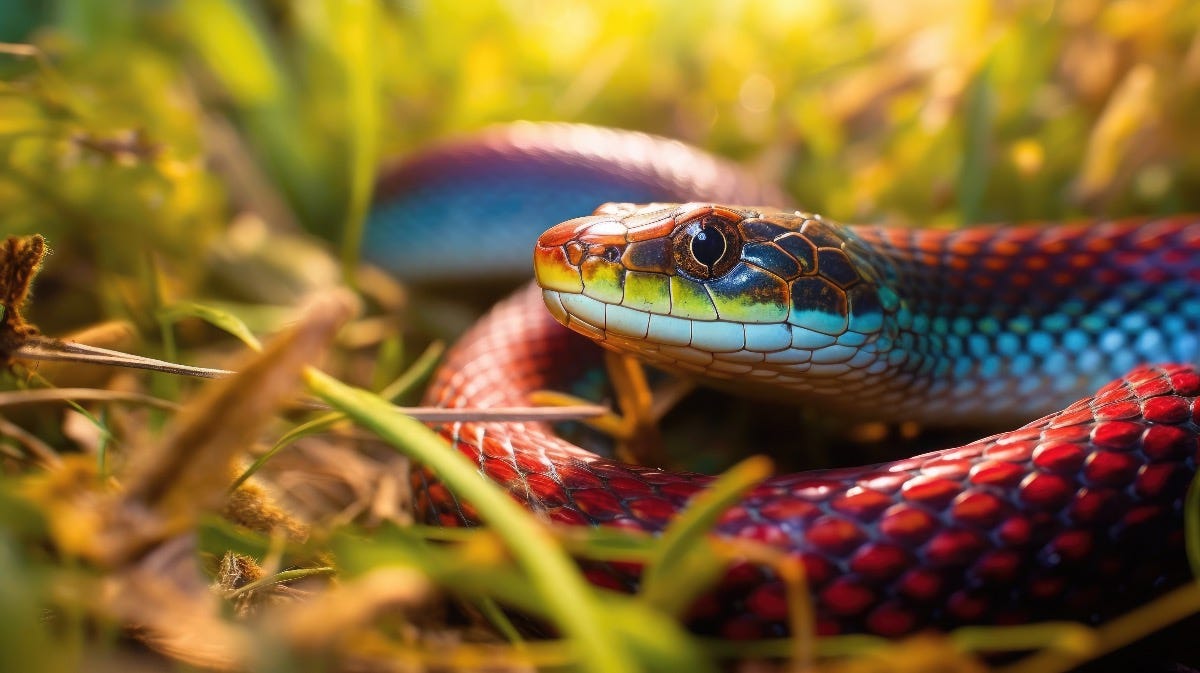Snake Haunted
A Flash Fiction by Fran Turner
Serena’s father takes her to the reptile house, his favourite place, on her seventh birthday. Perhaps because it is a gray, drizzly morning and they are the only visitors, it’s more special to be sharing it with him.
“Since I was your age, I’ve loved snakes,” he says as they walk to the row of glassed-in snake homes. But this smile contorts as he clutches at his chest, tugs at his collar. His body crumples to the floor.
The man in a green uniform rushes over, flicks on his walkie-talkie. “Might be a cardiac arrest! Reptile house!” He tips her father’s chin, breathes into his mouth, pushes on his chest.
Never before has Serena seen her father lying on the floor.
Zoo administrators and medics crowd around and she is nudged away. Useless and scared, she turns to the snakes. The tiny, moist pebbles of their eyes return her gaze and, later, she will remember the shift in her at that moment.
“Little girl, is that your father?” When she looks into the stranger’s face, a snake’s head looks down at her. Her panicked eyes dart away to see snakes carrying her father on a gurney. Serena screams and screams.
Instead of her mother with her perfectly lined eyes and honey-bee lips, a plain-bellied water snake comes to take her home. Non-venomous, her father told her about water snakes.
Serena knows better than to tell her mother about the snakes she sees everywhere. Because girls don’t like snakes and because you’re nuts when you see things that others insist aren’t there. Serena suffers her new world in silence, seeks help in the snake books her father gave her.
By the time she’s eight, she’s grown accustomed to snakes surrounding her, to her mother’s new thick copperhead husband coiled in the easy chair, his black forked tongue flicking excitedly as he watches Jeopardy. Her best friend Roxy is a pretty green whip snake but she doesn’t tell her that. Serena doesn’t tell anyone that when she looks in the mirror, a plain eastern garter snake looks back at her. Although she is lonely because of the secrets she keeps, she’s no longer afraid of the snakes she sees.
But the appearance of a king cobra in the playground, and a saw-scaled viper in line at the grocery store, gives her pause. With the constrictors—the sand python minister at her mother’s church, the rainbow boa trying to sell Serena a dress she can’t afford—she keeps her distance.
By the time she’s in college, most of the snakes haunting her life are harmless. Like Cleo, a fellow grad student, a cottonmouth, who some students and even professors find threatening—the way she rears her broad face back when she questions their assertions. But Serena loves to sit alongside Cleo basking in the warm sunshine of fall days as they read and discuss Paradise Lost.
When she starts work, the rattle of her boss, an eastern diamondback rattler, gives Serena warning plenty of time before he strikes. So she eases off with her demand for a raise. Reintroduces that discussion when he’s bloated, lazily digesting some other prey. A promotion comes along with her pay hike.
Serena sympathises with the snakes she sees, feels at ease even in crowds, because she understands that even the venomous ones spit toxin or squirt it from their fangs, not out of aggression, but because they’re afraid. Serena knows the mildly toxic bites she inflicts are delivered when she sees no escape. Like when her mother tells her she’s too introverted to get a man, too self-absorbed to start a family.
Boyfriends have tried to lure her with their coils and serpentine smiles, but dissuaded by her aloofness, they sidewind out of sight. Serena allows herself to dream that maybe someday, she will be able to tear away what keeps her cool and at a distance. That maybe someday she will slither and slide with a special someone in a pheromone-scented mating ball of two.
She tells no one that she will commemorate the death of her father twenty-five years ago with a visit to the Reptile House. The place she has always feared, a place of grief and loss.
No longer is it dreary, and a throng of visitors slither around the sophisticated exhibition. Serena pauses at each showcase, wonders if the unlidded eyes can see the snakes in the faces peering at them, wonders if the snakes can sense what they share with humans. Wonders if humans can sense what they share with snakes.
A bespectacled fellow, a San Francisco garter snake of a man—red head with turquoise underneath, vibrantly striped red and black—studies each snake, reads and re-reads the labels with the snake names and brief descriptive notes. She can’t help sliding herself in beside him as he pauses at the corn snake exhibit. Serena flashes him a smile.
“Snakes fascinate me,” he says. “You too. You care about them.” His words startle her, grip her heart. She blinks back tears.
He stares at Serena for a long moment. The recognition frightens her. She rubs at a film that covers her eyes. Then holds her hand to her tightening throat. She’s choking inside skin too taut.
“You okay? Let’s get some fresh air,” the man says. He leads her outside with a gentle hand barely touching her elbow.
Walking into fresh spring sunshine, Serena gasps as her snakeskin drops away and she sees all the human faces.
Author: Fran Turner grew up on a farm in Ontario, where she saw a copperhead and lots of garter snakes. But Toronto has always felt to be her home. She’s had stories published in Ekphrastic Review, Love in the Time of COVID, Oddity, Worthington Flash, Dodging the Rain, and Adelaide Review.
If you have enjoyed this story, please consider making a donation to our free-to-read literary journal.


